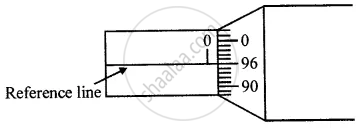Advertisements
Advertisements
Question
How do you account for negative zero error, for calculating the correct diameter of wires?
Solution
If the zero lines marked on a circular scale, is above the reference line of the main scale, then there is a negative error and the correction is positive.
In the figure, there is 96th division on the circular scale which coincides with the reference line.
∴ Correction = + [n − coinciding division of C.S. × L.C.]
where n is the total number of circular scale divisions.
∴ Correction = + [100 – 96] × 0.001 cm
= 0.004 cm
If observed diameter is 0.557 cm, then :
Corrected diameter
= Observed diameter + Correction
= 0. 557 cm + 0.004 cm
= 0.561 cm

APPEARS IN
RELATED QUESTIONS
Name the part of the vernier callipers which is used to measure the following
Depth of a small bottle
A screw gauge has a least count 0.001 cm and zero error +0.007 cm. Draw a neat diagram to represent it.
Name the instrument which has the least count
0.1 mm
A boy uses a vernier callipers to measure the thickness of his pencil. He measures it to be 1.4 mm. If the zero error of vernier callipers is +0.02 cm, what is the correct thickness of the pencil?
Fig., below shows the reading obtained while measuring the diameter of a wire with a screw gauge. The screw advances by 1 division on the main scale when circular head is rotated once.
 Find:
Find:
(i) Pitch of the screw gauge,
(ii) Least count of the screw gauge and
(iii) The diameter of the wire.
What is the backlash error?
State whether the following statement is true or false by writing T/F against it.
The metre scale, vernier calipers, and screw gauge are in decreasing order of least count.
What is the least count in the case of the following instrument?
Thermometer
